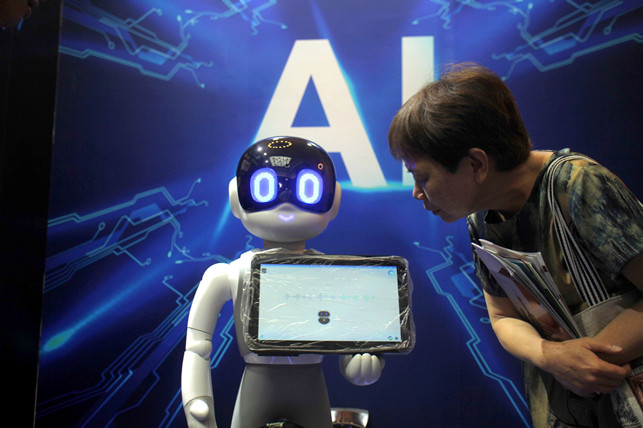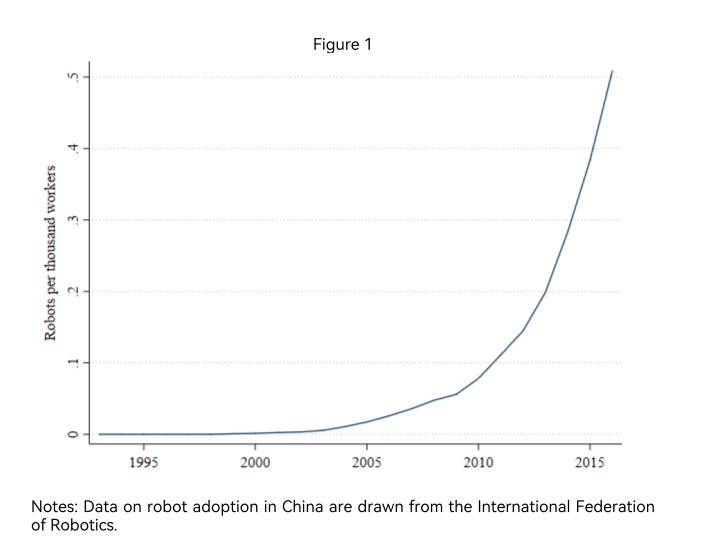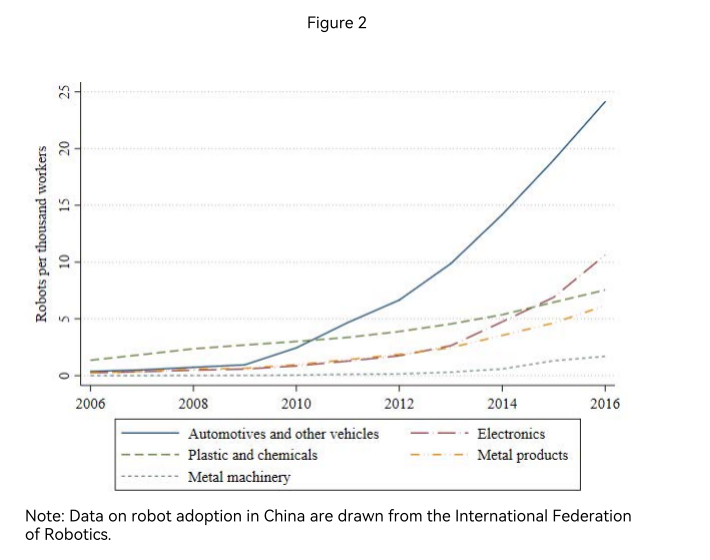How Do Workers and Households Adjust to Robots?
We analyze the effects of exposure to industrial robots on labor markets and household behaviors, exploring longitudinal household data from the China Family Panel Studies.

There is growing evidence of the effects of automation and, in particular, robots on the labor markets of advanced economies. Previous research has analyzed the effects of automation technologies and robots on these markets (Acemoglu and Restrepo 2020; Graetz and Michaels 2018; Borjas and Freeman 2019; Mokyr, Vickers, and Ziebarth 2015; Bessen et al. 2019). Yet, we still know relatively little about how workers and households may adjust to these labor market shocks (Dauth et al. 2021). Previous work has shown how industrial robots may have differential impact on men and women, affecting their marital behavior and fertility decisions (Anelli et al. 2021). New technologies may also influence family investment in children’s human capital by changing the expected marginal returns to children’s human capital and cognitive skills. Yet, these margins of adjustment at the worker and household levels have so far received limited attention. What are the effects on their consumption patterns? How does exposure to these technologies affect financial investment? Are there effects on training? And to what extent does increased exposure to these technological shocks affect parental investment in children? Furthermore, most of the work on automation and robots has focused on advanced economies. Given the different industry specializations of developing countries, and the larger role of routine agricultural and manufacturing work as compared to service sector jobs, jobs in developing countries are more likely to be automated. In fact, according to a recent World Bank (2016) estimate, 1.8 billion jobs, or roughly two-thirds of the labor force in developing countries, are susceptible to automation. With a much higher share of workers having a high school education or less, it will take time for workers to acquire the skills needed to benefit from the complementarities brought about by smart machines and automation (Yusuf 2017). The implications of robotization in emerging markets for jobs, growth, and inequality could be profound. Without employment creation, automation, digitalization, and labor-saving technologies may foster inequality. Consequently, developing countries may face new policy challenges and important economic trade-offs, such as the one between increased productivity and potential higher economic inequality and social unrest. At the same time Calì and Presidente (2022), examining data from Indonesia, provide evidence of gains in terms of both productivity and employment. How families will adjust to the rapid adoption of robots in these settings remains an open question.


In a recent study, we analyze how families responded to increased exposure to industrial robots in China, a country that over the last few years has massively invested in robots and automation. In 2014, China’s President Xi Jinping called for a robot revolution to boost the country’s manufacturing productivity. In its latest Five-Year Plan (2016–2020), the Chinese government has allocated billions of yuan for manufacturers to upgrade to technologies including robots and advanced machinery. Several Chinese provinces are also heavily subsidizing the adoption of robots. For instance, Guangdong province in southern China promised to spend $150 billion on industrial robots and new innovation centers dedicated to advanced automation. Figure 1 illustrates the incredible growth in robot adoption in China over the last few years. This trend was driven by the automotive and electronics sectors (Figure 2). Previous studies have analyzed the factors explaining the variation in robot adoption across Chinese firms, documenting how innovation subsidies are preferentially allocated to state-owned firms and politically connected firms (Cheng et al. 2019). These previous studies documented the adoption of robots by China’s manufacturers using aggregate industry-level and firm-level data (Cheng et al. 2019); examined how robot adoption may create skill-biased development in firms’ employment structure (Tang et al. 2021); and analyzed the effects of labor costs on the adoption of robots (Fan, Hu, and Tang 2021). However, the mechanisms of adjustment have received less attention, particularly in emerging economies.
In our study, we exploit household longitudinal data from the China Family Panel Studies to explore labor market adjustments and the dynamic response of workers and households more exposed to robot penetration. We exploit the variation in the preexisting distribution of industrial employment across Chinese cities and use changes in the number of robots across industries to create a measure of exposure to robots in China’s labor market. We first document significant negative effects on short-run wages and employment outcomes. We show that an increase by 1 standard deviation in robot exposure lowers an individual’s probability of being employed by 6 percentage points (-7.5% with respect to the mean), increases the likelihood of leaving the labor force by 1 percentage point (+10.5% with respect to the mean), and increases the likelihood of reporting unemployment status by 5 percentage points (or 0.17 standard deviations). Robot exposure reduces hourly income on average (-9%), but with no significant effect on annual income, as individuals in areas that are more exposed work longer hours (+14%). These effects are concentrated among low-skilled, male, and prime-age and older workers. An important contribution of our research is to analyze how individuals and families respond to the increased exposure to robots in the labor markets. We find that robot penetration significantly increases early retirement, especially among older workers, while younger workers are more likely to participate in technical or work-related training in response to robot competition. We then analyze the impact of robot exposure on families’ consumption decisions and financial behavior. Interestingly, we find no evidence of an effect on consumption or savings. While exposure to robots has negative effects on wages and employment opportunities, we document an increase in borrowing (+10%) that allows families to keep their consumption and savings constant. In addition, we examine the effects of robot exposure on marital behavior, fertility, and educational investment in children. While there is also no evidence of an effect on marital behavior, we find that robot exposure leads to a small decline in the number of children (-1.2%). Finally, we find that robot exposure increases family time investment in the education of children (+10%) as well as the investment in children’s after-school academic and extracurricular activities.
New technologies, artificial intelligence, and automation may have positive impacts on growth and productivity, which could eventually increase demand for higher-skilled workers. Our results suggest that in the short run the labor market may not adjust to such rapid and dramatic change. As income inequality increases in many emerging economies, this may pose further challenges to governments facing increased dissatisfaction among the population, particularly among those most exposed to the competition with new technologies. However, we also document how workers responded to the shock by increasing early retirement and technical training, highlighting the role of these channels of adjustment in the labor market. Households responded to the negative shock by increasing borrowing to keep savings and consumption constant. At the same time, more exposed households increased investment in the human capital of their children. Future research could shed light on whether exposure to robots affects the educational and career choices of young adults in developing economies so far characterized by heavy specialization in manufacturing industries. Whether productivity gains in the long-run translate into employment growth and how the political consequences of the labor market affect automation and digitization are important questions that demand further scientific investigation.
References
Acemoglu, Daron, and Pascual Restrepo. 2020. “Robots and Jobs: Evidence from US Labor Markets.” Journal of Political Economy 128 (6): 2188–2244. https://doi.org/10.1086/705716.
Anelli, Massimo, Osea Giuntella, and Luca Stella. 2021. “Robots, Marriageable Men, Family, and Fertility.” Journal of Human Resources 58 (2): 1020-11223R1. https://doi.org/10.3368/jhr.1020-11223R1.
Bessen, James, Martin Goos, Anna Salomons, and Wiljan van den Berge. 2019. “Automatic Reaction: What Happens to Workers at Firms That Automate?” Boston University School of Law and Economics Research Paper. https://dx.doi.org/10.2139/ssrn.3328877.
Borjas, George J., and Richard B. Freeman. 2019. “From Immigrants to Robots: The Changing Locus of Substitutes for Workers.” Russell Sage Foundation Journal of the Social Sciences 5 (5): 22–42. https://doi.org/10.7758/rsf.2019.5.5.02.
Calì, Massimiliano, and Giorgio Presidente. 2021. “Automation and Manufacturing Performance in a Developing Country.” University of Oxford Working Paper No. 2021-1. https://www.oxfordmartin.ox.ac.uk/publications/automation-and-manufacturing-performance-in-a-developing-country/.
Cheng, Hong, Ruixue Jia, Dandan Li, and Hongbin Li. 2019. “The Rise of Robots in China.” Journal of Economic Perspectives 33 (2): 71–88. https://doi.org/10.1257/jep.33.2.71.
Dauth, Wolfgang, Sebastian Findeisen, Jens Suedekum, and Nicole Woessner. 2021. “The Adjustment of Labor Markets to Robots.” Journal of the European Economic Association 19 (6): 3104–53. https://doi.org/10.1093/jeea/jvab012.
Fan, Haichao, Yichuan Hu, and Lixin Tang. 2021. “Labor Costs and the Adoption of Robots in China.” Journal of Economic Behavior & Organization 186: 608–31. https://doi.org/10.1016/j.jebo.2020.11.024.
Giuntella, Osea, Yi Lu, and Tianyi Wang. 2022. “How Do Workers and Households Adjust to Robots? Evidence from China.” NBER Working Paper No. 30707. https://doi.org/10.3386/w30707.
Graetz, Georg, and Guy Michaels. 2018. “Robots at Work.” Review of Economics and Statistics 100 (5): 753–68. https://doi.org/10.1162/rest_a_00754.
Mokyr, Joel, Chris Vickers, and Nicolas L. Ziebarth. 2015. “The History of Technical Anxiety and the Future of Economic Growth: Is This Time Different?” Journal of Economic Perspectives 29 (3): 31–50. https://doi.org/10.1257/jep.29.3.31.
Tang, Chengjian, Keqi Huang, and Qiren Liu. 2021. “Robots and Skill-Based Development in Employment Structure: Evidence from China.” Economics Letters 205: 109960. https://doi.org/10.1016/j.econlet.2021.109960.
World Bank Group. 2016. World Development Report 2016: Digital Dividends. World Bank Publications. https://www.worldbank.org/en/publication/wdr2016.
Yusuf, Shahid. 2017. “Automation, AI, and the Emerging Economies.” Center for Global Development, September 8, 2017. https://www.cgdev.org/publication/automation-ai-and-emerging-economies.
Related VoxEu
https://cepr.org/voxeu/columns/robots-economic-development
https://cepr.org/voxeu/columns/dont-blame-it-machines-robots-and-employment-europe
https://cepr.org/voxeu/columns/globalisation-and-rise-robots

Latest
Most Popular
- VoxChina Covid-19 Forum (Second Edition): China’s Post-Lockdown Economic Recovery VoxChina, Apr 18, 2020
- China’s Great Housing Boom Kaiji Chen, Yi Wen, Oct 11, 2017
- China’s Joint Venture Policy and the International Transfer of Technology Kun Jiang, Wolfgang Keller, Larry D. Qiu, William Ridley, Feb 06, 2019
- The Dark Side of the Chinese Fiscal Stimulus: Evidence from Local Government Debt Yi Huang, Marco Pagano, Ugo Panizza, Jun 28, 2017
- Wealth Redistribution in the Chinese Stock Market: the Role of Bubbles and Crashes Li An, Jiangze Bian, Dong Lou, Donghui Shi, Jul 01, 2020
- What Is Special about China’s Housing Boom? Edward L. Glaeser, Wei Huang, Yueran Ma, Andrei Shleifer, Jun 20, 2017
- Evaluating Risk across Chinese Housing Markets Yongheng Deng, Joseph Gyourko, Jing Wu, Aug 02, 2017
- Privatization and Productivity in China Yuyu Chen, Mitsuru Igami, Masayuki Sawada, Mo Xiao, Jan 31, 2018
- How did China Move Up the Global Value Chains? Hiau Looi Kee, Heiwai Tang, Aug 30, 2017
- China’s Shadow Banking Sector: Wealth Management Products and Issuing Banks Viral V. Acharya, Jun Qian, Zhishu Yang, Aug 09, 2017




 Facebook
Facebook  Twitter
Twitter  Instagram
Instagram WeChat
WeChat  Email
Email 


